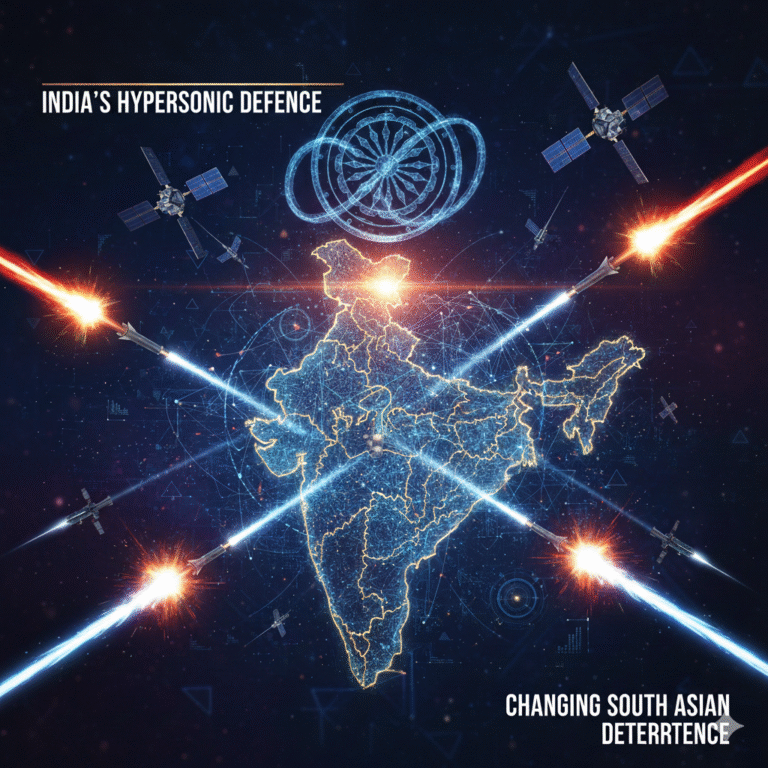Key Highlights
- Hypersonic missiles traveling above Mach 5 compress decision-making timeframes drastically
- Dual-use capabilities blur conventional-nuclear distinctions, raising escalation risks
- India joins elite group with successful HSTDV testing, achieving Mach 6 speeds
- Traditional missile defense systems prove inadequate against hypersonic maneuverability
- Arms control frameworks require urgent updating for hypersonic-nuclear integration
Introduction
The dawn of the hypersonic age marks a revolutionary shift in global military strategy. Hypersonic weapons—missiles traveling at speeds greater than Mach 5 with unprecedented maneuverability—are fundamentally challenging the nuclear deterrence architecture that has maintained strategic stability for decades. The emerging debate centers on whether these lightning-fast weapons undermine traditional nuclear deterrence principles or create new dimensions of strategic balance. thedialectics

The Foundation of Nuclear Deterrence
Nuclear deterrence has long served as the cornerstone of international security, built upon the principle of assured retaliation. The doctrine relies on maintaining credible second-strike capabilities that guarantee devastating retaliation even after absorbing a first strike. Established frameworks include Mutually Assured Destruction (MAD), No First Use policies, and credible minimum deterrence strategies.
India’s nuclear doctrine, established in 2003, exemplifies this approach with its No First Use (NFU) policy and credible minimum deterrence strategy. The doctrine assumes sufficient warning time and survivable nuclear forces to ensure effective retaliation.
How Hypersonic Weapons Disrupt the Nuclear Balance
Speed Compression: The Time Factor Crisis
Hypersonic missiles dramatically compress response timeframes, reducing decision-making windows from hours to mere minutes. Traditional ballistic missiles follow predictable parabolic trajectories, providing early warning through space-based sensors. Hypersonic weapons, however, maintain unpredictable flight paths within the atmosphere, making detection and tracking exponentially more difficult.
Defense System Obsolescence
Current missile defense architectures prove inadequate against hypersonic threats. Unlike ballistic missiles that can be intercepted during predictable boost and midcourse phases, hypersonic weapons perform terminal maneuvers at extreme speeds, evading interception attempts. The Congressional Research Service highlighted concerns that both terrestrial and space-based sensors cannot adequately detect and track hypersonic weapons.
The Preemptive Strike Temptation
The combination of speed and evasiveness creates incentives for preemptive use. Nations may feel compelled to “use-them-or-lose-them” when faced with incoming hypersonic threats, as the compressed timeframe eliminates measured response options. This dynamic directly undermines the stability that nuclear deterrence depends upon.

The Dual-Use Dilemma
Perhaps the most destabilizing aspect of hypersonic weapons is their dual-use nature—the ability to carry either conventional or nuclear warheads. This ambiguity creates what experts call “warhead uncertainty,” where defenders cannot determine payload type until impact. Such uncertainty increases the risk of nuclear escalation, as decision-makers may assume the worst-case scenario and respond with nuclear weapons to what might be conventional strikes.
India’s Hypersonic Journey: The HSTDV Program
India has emerged as a significant player in hypersonic technology through its Hypersonic Technology Demonstrator Vehicle (HSTDV) program. The Defence Research and Development Organisation (DRDO) has achieved remarkable milestones:
Historical Progress:
- 2004: Initial HSTDV program conceptualization
- 2020: Successful scramjet ignition at Mach 6 for 20 seconds
- 2024: World-record scramjet combustion for 1,000 seconds
- November 2024: First long-range hypersonic missile test exceeding 1,500 km range

The latest achievement places India among an elite group including the United States, Russia, and China with operational hypersonic capabilities. India’s approach focuses on indigenous scramjet technology, which compresses incoming air for combustion during hypersonic flight.
Strategic Responses and Technological Countermeasures
Defensive Adaptations
Nations are developing advanced tracking and interception technologies to counter hypersonic threats. These include:
- Glide Phase Interceptors: Designed to target hypersonic vehicles during their gliding phase
- Space-Based Sensors: Enhanced satellite networks for continuous tracking
- Directed-Energy Weapons: Laser systems potentially capable of engaging hypersonic targets
Doctrinal Evolution
Military doctrines worldwide are adapting to incorporate hypersonic realities. The U.S. has reversed its position on hypersonic arms control, now seeking to include these weapons in strategic limitations. Russia and China continue advancing their hypersonic arsenals, with Russia’s Avangard and China’s GDF-600 representing operational capabilities.
Geopolitical Ramifications
Accelerating Arms Race
The hypersonic revolution is triggering a new arms race among major powers. Defense spending on hypersonic programs has increased dramatically, with Japan requesting $547 million for fiscal 2024 alone. The United Kingdom launched its hypersonic initiative in 2023, recognizing the strategic imperative.
Regional Stability Concerns
In South Asia, hypersonic weapons pose particular challenges due to short flight distances between India and Pakistan—typically 5-10 minutes for ballistic missiles. Hypersonic weapons could reduce this timeframe further, compressing the Observe-Orient-Decide-Act (OODA) loop to dangerous levels.
Arms Control Challenges
Current arms control frameworks prove inadequate for hypersonic weapons. The New START Treaty between the United States and Russia does not explicitly cover hypersonic systems, creating a “hypersonic gap” in nuclear arms control. The treaty’s language applies specifically to weapons with “ballistic trajectory over most of its flight path,” excluding gliding hypersonic systems.
India’s Strategic Positioning
Nuclear Doctrine Implications
India’s development of hypersonic weapons raises questions about its traditional NFU policy. Defense analysts suggest that hypersonic capabilities might provide India with options for conventional precision strikes while maintaining nuclear deterrence. The dual-use nature of these systems creates strategic ambiguity that could enhance deterrence but also increase escalation risks.
Integration Challenges
India faces several challenges in integrating hypersonic weapons into its strategic framework:
- Command and Control: Ensuring reliable communication and control over hypersonic systems
- Survivability: Protecting hypersonic assets from preemptive strikes
- Nuclear Triad Balance: Incorporating hypersonic weapons into land, sea, and air-based nuclear forces
Policy Recommendations and Future Directions
Technology Investments
Nations must invest in both offensive and defensive hypersonic capabilities. India should continue advancing its scramjet technology while developing countermeasures against adversaries’ hypersonic weapons. The recent DRDO achievements in sustaining scramjet combustion represent crucial progress.
Arms Control Adaptation
International community must update arms control frameworks to address hypersonic weapons explicitly. This includes:
- Expanding New START language to cover hypersonic glide vehicles
- Developing verification protocols for dual-use systems
- Creating transparency measures for hypersonic deployments
Strategic Communication
Enhanced dialogue between nuclear powers becomes critical in the hypersonic era. Confidence-building measures and crisis management protocols must account for compressed decision timeframes. Hot-line communications and automated systems may require upgrading to function in hypersonic scenarios.
Regional Cooperation
South Asian nations should explore regional agreements to manage hypersonic proliferation. This could include notification agreements for hypersonic tests and restrictions on certain deployment patterns.
The Road Ahead
The hypersonic revolution represents both opportunity and peril for global security. While these weapons provide new strategic capabilities, they also compress reaction times and blur conventional-nuclear distinctions in dangerous ways. The challenge lies in harnessing hypersonic technology’s benefits while maintaining strategic stability.
India’s successful entry into the hypersonic club demonstrates indigenous technological capabilities while raising questions about regional stability. As hypersonic weapons proliferate, the international community must work urgently to develop new frameworks for managing their destabilizing potential.
The future of nuclear deterrence increasingly depends on adapting Cold War concepts to hypersonic realities. Success requires technological innovation, doctrinal evolution, and unprecedented international cooperation to prevent the hypersonic age from becoming an age of instability.









+ There are no comments
Add yours